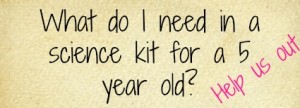
I am hoping all my science loving homeschooling parents/teachers can help me out. I am planning on putting together a Science style work station for my 5 year old for her birthday.
I think this will make a great present as she is not into the usual barbie dolls and trinkets. She loves making “concoctions” as she calls them. She can make edible concoctions in the kitchen to making blends of different creams and oils to create a homemade salve for a make believe ailment.
What should this science kit contain?
I am thinking it would have containers of the usual science suspects – vinegar, baking soda, mentos, salt, oil, flour, corn flour etc.
I managed to get some PH testing strips off ebay 50 for $1 which I thought she could use for dipping and pretend testing things.
Please share your inputs here below and guide me into creating a magical science suggestion for her.
Check out this article on the best STEM gifts for kids.
Check out our Online store for special buys on Educational gifts We find bulk items and end-of-stock supplies to bring you heavily discounted items. (make sure you check our store often so you don’t miss out on new stock). We also have some free printable files, including a Science PDF for learning about Microscopes.
 As an American, I feel like I should know more about Canada than I do. No matter where you live, let’s learn about this large country that borders the United States.
As an American, I feel like I should know more about Canada than I do. No matter where you live, let’s learn about this large country that borders the United States.
I’ve made a couple science kits with a downloadable workbook for kids. If you’d like to check it out, it’s here: http://stitchesandsnps.blogspot.com/2012/01/diy-kids-science-kit-with-download.html
The list of “ingredients” is at the front of the download. I hope this helps!
Red cabbage! Boil it up and save the water – this makes a good indicator instead of pH paper.
Sugar! Make a concentrated sugar solution and suspend a piece of cotton thread in it. Crystals will grow on the thread.
Food colouring. Stand white flowers in it – or celery – and watch the colours move up the stem.
I could keep going, but I’ll stop there!
Don’t forget the protective gear! A pair of safety glasses and some kind of apron/coat to carry out experiments in. You could even personalise them for her.
Baking soda, cornflour, vinegar, borax, glitter, glue, various ‘utensils’, jello … gosh options are endless ….
Having safety glasses and a lab coat (an old white dress shirt works great) is important. It starts her out with good habits and it is a physical reminder that she is doing something different. That is critically important to keep her from mixing her ‘science’ with her food and other things. While you are not going to get her anything that is toxic, you want to be sure that she doesn’t eat her experiments or put her pH paper in food she is going to eat.
Also, provide her with a clear set of rules about what it is OK to experiment with (the things in the box) and what isn’t (the things in the fridge etc. You need to have rules for collecting things in nature as well. Make sure she has a place to store things that she wants to watch and make sure that she knows to clean up.
Some other things you might find fun:
-Science only plastic measuring cups and spoons… things to use to measure and weigh.
– A lab notebook to record her experiments, draw pictures of results, make graphs… You can use this to help her plan her experiments, think about what might happen and explain things.
– A large sheet of black craft foam as a ‘lab bench’ to help keep things clean.
– A good quality magnifying glass.
– tweezers (Good for developing manual dexterity).
– Found objects to sort and classify.
– a box of tissues for cleaning up little spills
– plastic pipettes are fun http://www.sciplus.com/p/PIPET_44907
– soil, seeds, pots or egg cartons
– You might also add some kid friendly guides to rocks or plants.
– zip lock bags for storing or keeping the air out.
– A pocket microscope can be fun and likely better than any toy one you might find.
– You can purchase some specialty items like plastic test tubes and petri dishes in small quantities through places like American Science and Surplus. http://www.sciplus.com/s/c_11 or Steve Spangler http://www.stevespanglerscience.com/products.html which may be pricier but has great resources for explaining the experiments.
I am sure there are others but these two are set up to sell to the general public.
Excellent ideas thank you so much. I had totally forgotten the obvious. The coat and glasses 🙂
Hadn’t thought of glitter or jello so thank you for those fun suggestions.
Don’t stop! they are fun and exciting ideas 🙂
Love your activities – Thanks for sharing.